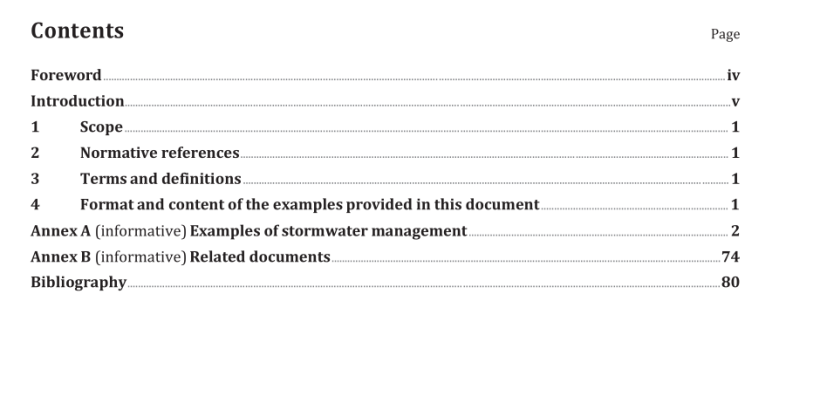ISO/TR 24539:2021 pdf download – Service activities relating to drinking water supply, wastewater and stormwater systems — Examples of good practices for stormwater management.
1 Scope This document provides examples of good practices in stormwater management related to ISO 24536 and information on standards and guidelines used in various countries. 2 Normative references There are no normative references in this document. 3 Terms and definitions No terms and definitions are listed in this document. ISO and IEC maintain terminological databases for use in standardization at the following addresses: — ISO Online browsing platform: available at https://www.iso .org/obp — IEC Electropedia: available at http://www.electropedia .org/ 4 Format and content of the examples provided in this document Examples of stormwater management introduced here are classified by country and are described in Annex A . They are also classified according to the objectives in ISO 24536:2019, Table 1, and are shown in Table A.1. The examples were provided by country representatives and adapted to the format of this document. In addition, although various standards and guidelines are described in Annex B , Table B.1 and Table B.2, they are shown only as a name and a reference URL. Table 1 illustrates the structure of the examples included in Annex A .
A.2 Australia A.2.1 Creation of a wetland in Mt Barker A.2.1.1 Background A new Environmental Services Centre is planned for Mt Barker adjacent to a wastewater treatment plant, Mt Barker Creek and a high school. The area has a long history of disturbance being a former abattoir, tannery and now informal council works storage area. Despite this disturbance, Lathan’s snipe (an endangered migratory bird from Siberia) and many other bird species have been sighted along the flood plain area. A.2.1.2 Purpose As part of planning for the Environmental Services Centre, a wetland and surrounding landscape was built to achieve multiple objectives, including: — creating habitat for the Lathan’s snipe and other birds species; — becoming a recreational asset with high amenity, providing links to a linear trail along Mt Barker Creek and connecting to the school and depot; — rehabilitating vegetation and creating a seed bank for local provenance plants in a range of ecosystems; — providing stormwater treatment for runoff generated by the new depot and car park;
A.2.1.3 Outline This project was developed to rehabilitate a degraded area on the banks of Mt Barker Creek as part of a planned council depot construction. The central component of the project is a constructed wetland which will protect the creek from increased pollutants, provide habitat for rare and endangered bird species and become a recreational node along the Mt Barker Creek linear path. A broader objective of the project is to rehabilitate a range of ecological habitats surrounding the wetlands, including grasslands, wet and dry woodlands and riparian areas. Much of the impetus for the initiative is to improve habitat for a range of rare and endangered birds and therefore the design involved close consultation with Birds SA. The design provides a range of ecological habitats for vegetation and bird species yet provides secluded areas where birds will not be disturbed. Walking paths, viewing decks and a boardwalk encourage people to enjoy the wetland but manage their access and allow a variety of habitats to be created (riparian inundation, open grassland, tussock grassland and wet woodlands). The 6 000 m wetland was constructed in 2014 and an extensive search was performed to source local provenance plant species to use in the wetlands. A thorough mapping exercise was undertaken during planting to enable the wetland to serve as a seedbank for these rare local species into the future. The wetland also provides best practice stormwater treatment for runoff from the (future) depot thus helping to protect Mt Barker Creek and ultimately the Bremer River from urban stormwater pollutants (see Figure A.1).
